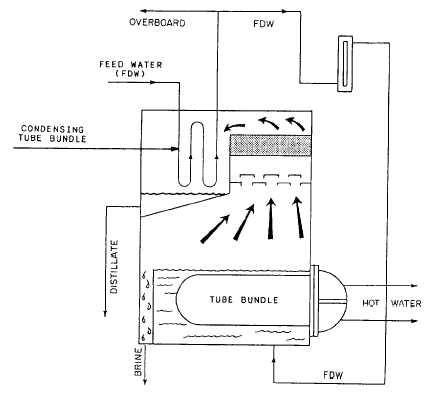the cold, partially-dried air flows into a desiccant
section, where the desiccant absorbs additional moisture
from the air.
DISTILLING PLANTS
Distilling plants are used to supply fresh water and
boiler feedwater. Distillers use either steam, hot water,
or electrical energy to boil seawater.
The majority of Navy ships have steam-heated
distilling plants. There are three types of steam-heated
distilling plants–submerged tube, flash, and vapor
compression. Of these types, the submerged-tube heat
recovery and flash are the most widely used.
Heat recovery units are used in vessels with engine
propulsion or auxiliary engines. Two variations of the
heat recovery types are used; both use the heat from
engine cooling systems for evaporization of seawater.
In one model of a heat recovery plant, the heat of
the diesel engine jacket water is transferred to the
seawater in a heat exchanger. The heated seawater is
then flashed to freshwater vapor as in the flash-type
distilling unit. In the second variation, the hot diesel
engine jacket water is circulated through a tube bundle
that is submerged in seawater. The seawater is boiled in
a chamber that is under vacuum as in the submerged tube
distilling unit.
Refer to figure 10-31, which shows a simplified
flow diagram for a 12,000 gpd (gallons per day), Model
S500ST, submerged-tube recovery unit. In this recovery
unit, jacket water from the ship’s main propulsion
diesels is fed to a tube bundle. The tube is submerged in
the seawater that will be evaporated. The jacket water
imparts its heat to the seawater surrounding the tubes,
which induces seawater evaporation. The vapor created
by the evaporating seawater is drawn through vapor
separators to the distillate condensing tube bundle. The
temperature of evaporation is maintained below the
normal 212°F boiling point by a feedwater-operated air
eductor. The eductor mechanically evacuates air and
gases entrained in the vapor formed in the evaporating
process and creates an internal shell pressure as low as
2 1/2 psia.
The flash-type distilling plant (fig. 10-32) has
preheater that heat seawater to a high temperature.
Then, the seawater is admitted to a vacuum chamber
where some of it flashes to vapor. The remaining
seawater is directed to another vacuum chamber
maintained at an even lower vacuum. Here, more
seawater flashes to vapor. At this point, the remaining
Figure 10-31.—Simplified flow diagram-heat recovery unit.
10-34


